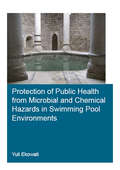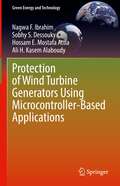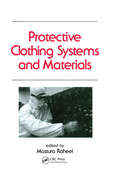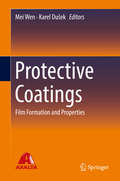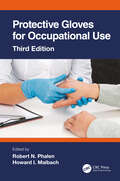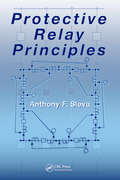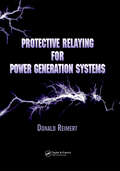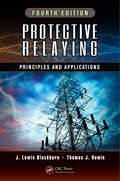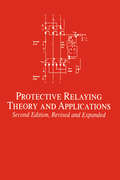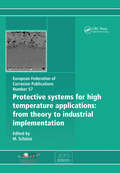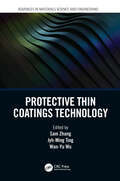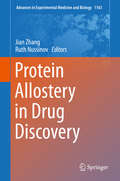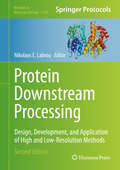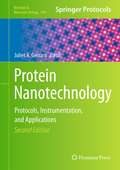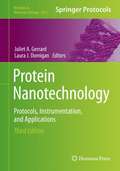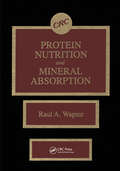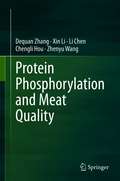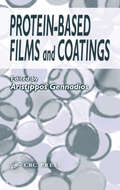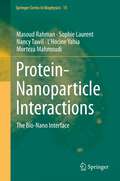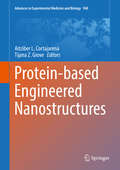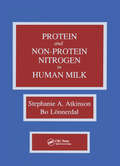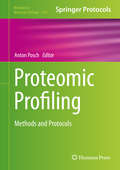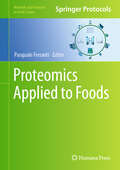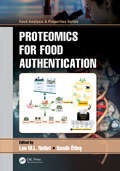- Table View
- List View
Protection of Public Health from Microbial and Chemical Hazards in Swimming Pool Environments (IHE Delft PhD Thesis Series)
by Yuli EkowatiThis thesis describes the occurrence of microbial and chemical contaminants in swimming pools and the investigation of an alternative disinfection technology, UVOX Redox® that could reduce reliance on chlorine and the formation of chlorinated disinfection byproducts (DBPs) in swimming pools. This technology was effective in inactivation of chlorine resistant microorganisms, represented by Bacillus subtilis spores, and in combination with chlorine generated lower concentrations of chlorinated DBPs compared to chlorination alone. It enhanced the removal of pharmaceuticals and personal care products (PPCPs), which were frequently present in indoor, outdoor and spa pools. Carbamazepine and 1H-benzotriazole were the most frequently detected PPCPs, while hydrochlorothiazide and 4-methylbenzylidene camphor were detected at the highest concentration. An investigation of seven different swimming pool facilities showed that clinically relevant fungi were omnipresent. Floors at the sites where the pool visitors converge, such as the exit leading to shower rooms, showed the highest fungal concentrations. The distribution of fungi inside the swimming pool facilities highlighted potential transmission pathways and a possible risk of fungal infections. Future swimming pool water guidance should include raising awareness among swimmers, pool operators and managers about hygienic behaviour and better hygiene measures, and application of alternative disinfection technologies such as UVOX. Key features: Identifies clinically relevant fungi in swimming pool environments Identifies potential transmission pathways of clinically relevant fungi in indoor swimming pools Highlights the occurrence of PPCPs in different type of pools and their relation with pool water treatment Assesses an alternative disinfection technology for swimming pool water treatment.
Protection of Wind Turbine Generators Using Microcontroller-Based Applications (Green Energy and Technology)
by Nagwa F. Ibrahim Sobhy S. Dessouky Hossam E. Mostafa Attia Ali H. Kasem AlaboudyProtection of Wind Turbine Generators Using Microcontroller-Based Applications focuses on the application of microcontrollers in the protection of wind turbine generators. The book looks at the design and implementation of a versatile digital overcurrent (OC), OV/UV, OF/UF, and negative sequence relays, and addresses the dynamic behaviour of a wind-driven induction generator (IG) connected to a power system grid through a transmission line. The transient responses of protective devices associated with the IG are also studied. Modelling of the digital relay for wind turbine generator protection using MATLAB Simulink consider most of the aerodynamic and mechanical effects that can influence instantaneous output voltage, current, and power. Coverage also includes different AC fault types, a detailed theoretical analysis of fault and protection strategy in AC fault, and the different types of fault detection algorithms to maintain power system reliability.
Protective Clothing Systems and Materials (Occupational Safety and Health)
by Mastura Raheel"Providing fundamental knowledge related to worker protection from chemical, thermal, and biological hazards, this practical reference focuses on recent scientific and technical developments in protective apparel systems. Introduces relevant health and safety legislation and rulings for worker safety!"
Protective Coatings
by Mei Wen Karel DušekThis book focuses on characterization of organic coatings by different testing methods and understanding of structure formation and materials properties. The knowledge of protective organic coatings and current test methods is based largely on empirical experience. This book aims at explaining the coating property changes during film drying and curing in terms of chemical and physical transformations. Current test methods are reviewed with emphasis on understanding their physical basis and expressing the test results in terms of comparable physical quantities. In general, this book provides readers a deeper understanding of the binder design, coating film formation process, properties build-up, appearance and defect formation, and automotive paint application. It also suggests manifold ways to improving the coatings performance. This book is designed for coating professionals to gain deeper understanding of characterization techniques and to select the right ones to solve their coating problems. It is ideal for both experienced and early career scientists and engineers. Also, it is useful for graduate students in the general area of protective coatings.
Protective Gloves for Occupational Use
by Robert N. Phalen and Howard I. MaibachThis revised text discusses key aspects for protective gloves, including glove materials, the manufacture of gloves, how to perform testing of gloves, and glove performance. The book provides guidance on how to select gloves to prevent skin contamination from chemical and microbial exposure in the occupational environment and presents hard-to-find information in one easy-to-use resource. It covers important concepts, including prevention of contact dermatitis, clinical testing of occupation-related glove sensitivity, and infection control and preventative measures for pandemics. The book • Provides update state-of-the-art information, practices, standards, and guidelines. • Covers information on protective glove material technology, protective effects, and adverse medical effects. • Explores ways to select gloves to prevent skin contamination from chemical and microbial exposure in the occupational environment. • Discusses concepts, including glove materials, the manufacture of gloves, how to perform testing of gloves, and glove performance according to standardized technical methods in vivo. The text will be useful for professionals in the fields of occupational and industrial hygiene, health care, and public health. It will also help graduate students in the fields of chemistry, chemical engineering, mechanical engineering, biology, pharmacy, and environmental health. This book offers a wealth of information on protective glove material technology, protective effects, and adverse medical effects. It gives detailed discussion of parameters, including the selection and use of gloves for industrial chemicals, acrylates, and pesticides, and gloves as protection against microbial contamination. It will be a valuable resource for professionals and graduate students in the fields of occupational and industrial hygiene, healthcare, public health, chemistry, chemical engineering, mechanical engineering, biology, pharmacy, and environmental health.
Protective Measurement and Quantum Reality
by Shan GaoProtective measurements offer an intriguing method for measuring the wave function of a single quantum system. With contributions from leading physicists and philosophers of physics - including two of the original discoverers of this important method - this book explores the concept of protective measurement, investigating its broad applications and deep implications. Addressing both physical and philosophical aspects, it covers a diverse range of topics, including experimental possibility of protective measurements, connections with the PBR theorem, and the implications of protective measurements for understanding the nature of quantum reality. Including a clear and concise introduction to standard quantum mechanics, conventional measurements, and the fundamentals of protective measurements, this is a valuable resource for graduate students and researchers interested in the conceptual foundations of quantum mechanics.
Protective Relay Principles
by Anthony M. SlevaImprove Failure Detection and Optimize ProtectionIn the ever-evolving field of protective relay technology, an engineer’s personal preference and professional judgment are as important to power system protection as the physical relays used to detect and isolate abnormal conditions. Invaluable Insights from an Experienced Expert Protective Relay Principles focuses on probable power system failure modes and the important characteristics of the protective relays used to detect these postulated failures. The book presents useful new concepts in a way that is easier to understand because they are equally relevant to older, electromechanical and solid-state relays, and newer, more versatile microprocessor-based relays. It introduces the applications, considerations, and setting philosophies used in transmission-line, distribution-line, and substation applications, covering concepts associated with general system operations and fault detection. Topics include relay load limits, cold load pickup, voltage recovery, and arc flash. The author also delves into the philosophies that engineers employ in both urban and rural areas, with a detailed consideration of setpoint function.Analysis of Key Concepts That Are Usually Just Glossed OverThis versatile text is ideal for new engineers to use as a tutorial before they open the instruction manuals that accompany multi-function microprocessor-based relays. Guiding readers through the transient loading conditions that can result in relay misoperation, the author elaborates on concepts that are not generally discussed, but can be very helpful in specific applications. Readers will come away with an excellent grasp of important design considerations for working with overcurrent, over- and undervoltage, impedance, distance, and differential type relay functions, either individually or in combination. Also useful for students as a textbook, this book includes practical examples for many applications, and offers guidance for more unusual ones.
Protective Relaying for Power Generation Systems (Power Engineering (Willis) #Vol. 69)
by Donald ReimertPower outages have considerable social and economic impacts, and effective protection schemes are crucial to avoiding them. While most textbooks focus on the transmission and distribution aspects of protective relays, Protective Relaying for Power Generation Systems is the first to focus on protection of motors and generators from a power generation perspective. It also includes workbook constructions that allow students to perform protection-related calculations in Mathcad® and Excel®.This text provides both a general overview and in-depth discussion of each topic, making it easy to tailor the material to students' needs. It also covers topics not found in other texts on the subject, including detailed time decrement generator fault calculations and minimum excitation limit. The author clearly explains the potential for damage and damaging mechanisms related to each protection function and includes thorough derivations of complex system interactions. Such derivations underlie the various rule-of-thumb setting criteria, provide insight into why the rules-of-thumb work and when they are not appropriate, and are useful for post-incident analysis. The book's flexible approach combines theoretical discussions with example settings that offer quick how-to information.Protective Relaying for Power Generation Systems integrates fundamental knowledge with practical tools to ensure students have a thorough understanding of protection schemes and issues that arise during or after abnormal operation.
Protective Relaying: Principles and Applications, Fourth Edition
by Thomas J. Domin J. Lewis BlackburnThis fourth edition of a bestseller covers the technological fundamentals of power system protection. Featuring refinements and additions to accommodate recent advances, the text describes analysis of protective systems during system disturbances and examines how regulations impact the way protective relaying systems are designed, applied, set, and monitored. Containing an expanded discussion of intertie protection requirements at dispersed generation facilities, it explores smarter, more flexible protective systems yet provides practical information on an array of equipment vintages to reflect the state of power systems today.
Protective Relaying: Theory and Applications
by Walter A. ElmoreTargeting the latest microprocessor technologies for more sophisticated applications in the field of power system short circuit detection, this revised and updated source imparts fundamental concepts and breakthrough science for the isolation of faulty equipment and minimization of damage in power system apparatus. The Second Edition clearly descri
Protective Systems for High Temperature Applications EFC 57: From Theory to Industrial Implementation
by M. SchutzeThis book is a review of corrosion and thermal protection topics associated with coatings applied in high temperature applications, namely catalytic converters, combustion and steam environments, and gas turbines. Information on corrosion influencing mechanisms and their impact are reviewed.
Protective Thin Coatings Technology (Advances in Materials Science and Engineering)
by Sam Zhang Jyh-Ming Ting Wan-Yu WuHard or protective coatings are widely used in conventional and modern industries and will continue to play a key role in future manufacturing, especially in the micro and nano areas. Protective Thin Coatings Technology highlights the developments and advances in the preparation, characterization, and applications of protective micro-/nanoscaled films and coatings. This book Covers technologies for sputtering of flexible hard nanocoatings, deposition of solid lubricating films, and multilayer transition metal nitrides Describes integrated nanomechanical characterization of hard coatings, corrosion and tribo-corrosion of hard coatings, and high entropy alloy films and coatings Investigates thin films and coatings for high-temperature applications, nanocomposite coatings on magnesium alloys, and the correlation between coating properties and industrial applications Features various aspects of hard coatings, covering advanced sputtering technologies, structural characterizations, and simulations, as well as applications This first volume in the two-volume set, Protective Thin Coatings and Functional Thin Films Technology, will benefit industry professionals and researchers working in areas related to semiconductors, optoelectronics, plasma technology, solid-state energy storages, and 5G, as well as advanced students studying electrical, mechanical, chemical, and material engineering.
Protein Allostery in Drug Discovery (Advances in Experimental Medicine and Biology #1163)
by Ruth Nussinov Jian ZhangThe book focuses on protein allostery in drug discovery. Allosteric regulation, ʹthe second secret of lifeʹ, fine-tunes virtually most biological processes and controls physiological activities. Allostery can both cause human diseases and contribute to development of new therapeutics. Allosteric drugs exhibit unparalleled advantages compared to conventional orthosteric drugs, rendering the development of allosteric modulators as an appealing strategy to improve selectivity and pharmacodynamic properties in drug leads. The Series delineates the immense significance of protein allostery—as demonstrated by recent advances in the repertoires of the concept, its mechanistic mechanisms, and networks, characteristics of allosteric proteins, modulators, and sites, development of computational and experimental methods to predict allosteric sites, small-molecule allosteric modulators of protein kinases and G-protein coupled receptors, engineering allostery, and the underlying role of allostery in precise medicine. Comprehensive understanding of protein allostery is expected to guide the rational design of allosteric drugs for the treatment of human diseases. The book would be useful for scientists and students in the field of protein science and Pharmacology etc.
Protein Downstream Processing: Design, Development, and Application of High and Low-Resolution Methods (Methods in Molecular Biology #2178)
by Nikolaos E. LabrouThis second edition volume expands on the previous edition with updated research and techniques to help laboratory workers design and implement a successful purification strategy, emphasize critical aspects on practical problems, and answers questions encountered at the lab bench. The chapters in this book are divided into five parts: Part One discusses an overview of screening and design of purification strategies and covers initial aspects on high-throughput screening, methods development, and media selection; Parts Two and Three explore low- and high-resolution methods, with emphasis on affinity chromatography; Part Four describes analytical techniques of purified proteins; and Part Five presents selected examples and case studies to discuss the aforementioned. Written in the highly successful Methods in Molecular Biology series format, chapters include introductions to their respective topics, lists of the necessary materials and reagents, step-by-step, readily reproducible laboratory protocols, and tips on troubleshooting and avoiding known pitfalls.Authoritative and comprehensive, Protein Downstream Processing: Design, Development, and Application of High and Low-Resolution Methods, Second Edition is an ideal source of information to advanced students, junior researchers, and scientists involved in health sciences, cellular and molecular biology, biochemistry, biotechnology, and other related areas in both academia and industry.
Protein Nanotechnology
by Juliet A. GerrardSince the first edition of Protein Nanotechnology Protocols Instruments and Applications the intersection of protein science and nanotechnology has become an exciting frontier in interdisciplinary sciences. The second edition of Protein Nanotechnology Protocols Instruments and Applications expands upon the previous editions with current, detailed chapters that provide examples of proteins which are now being harnessed for a wide range of applications, some more developed than others. This book also delves into engineering proteins and an overview of the sorts of tools that are now readily available to manipulate the structure and function of proteins, both rationally and using methods inspired by evolution. Written in the highly successful Methods in Molecular BiologyTM series format, chapters include introductions to their respective topics, lists of the necessary materials and reagents, step-by-step, readily reproducible laboratory protocols, and key tips on troubleshooting and avoiding known pitfalls. Authoritative and practical, Protein Nanotechnology Protocols Instruments and Applications, Second Edition seeks to provide an overview of this multi-faceted field and a useful guide to those who wish to contribute to it.
Protein Nanotechnology: Protocols, Instrumentation, and Applications (Methods in Molecular Biology #2073)
by Juliet A. Gerrard Laura J. DomiganThis third edition volume expands on the previous editions with updated approaches and techniques used to study protein nanotechnology and the future of nanomaterial compositions. This book is organized into Three Parts: Part One looks at recombinant protein expression in insect cells, and methods to produce molecular motors, molecular superglues, and protein templates; Part Two explores functionalization strategies and ways to incorporate functional protein components into nanodevices; Part Three discusses various instrumental techniques used to study protein nanostructures. Written in the highly successful Methods in Molecular Biology series format, chapters include introductions to their respective topics, lists of the necessary materials and reagents, step-by-step, readily reproducible laboratory protocols, and tips on troubleshooting and avoiding known pitfalls. Cutting-edge and thorough, Protein Nanotechnology: Protocols, Instrumentation, and Applications, Third Edition is a valuable resource for any researchers looking to expand their knowledge in this evolving field.
Protein Nutrition and Mineral Absorption
by Raul A. WapnirThis volume presents information regarding the mechanisms of protein absorption under normal and pathologic conditions, in addition to reviewing changes that occur at various stages of life. General modifiers of intestinal absorption, such as the processing of foods, the nutritional status of the individual, and disease, are explored with reference to both proteins and minerals. Inorganic macronutrients, namely calcium, magnesium and phosphorus, are discussed in relation to protein ingestion. The book also explores the concept of essential trace elements (e.g., iron, zinc, copper, and iodine) and their link to protein sufficiency. The relationship of ultratrace elements with the content of proteins in food is examined, and the book offers a fresh view of the role of certain elements, particularly zinc, on the conformation of proteins linked to DNA, hormone receptors, and gene products. Protein Nutrition and Mineral Absorption is packed with 2,300 references, 100 figures and graphs, plus 25 tables. Nutritionists and physicians will find this book to be an invaluable reference source for rationalizing nutritional interventions and diet modifications for their patients.
Protein Phosphorylation and Meat Quality
by Xin Li Li Chen Zhenyu Wang Dequan Zhang Chengli HouThe book focuses on the current research of the relation between protein phosphorylation and meat quality, reviews the influence mechanism of protein phosphorylation on meat quality, and summarizes the improvement of meat quality by regulating protein phosphorylation. It could help to clarify some dilemmas and encourage further research in this field, aiming for effective application of protein phosphorylation in meat quality in the near future. The book is written for researchers and graduate students in the field of meat science, food chemistry and molecular biology etc.
Protein-Based Films and Coatings
by Aristippos GennadiosThis volume presents the most up-to-date and detailed information available on protein-based biopolymer films and coatings. It provides a comprehensive overview of the design, technology, properties, functionality, and applications of biopolymer films and coatings (edible and inedible) from plant and animal proteins. Both widely commercialized and
Protein-Nanoparticle Interactions: The Bio-Nano Interface
by Morteza Mahmoudi Masoud Rahman Nancy Tawil Sophie Laurent L'Hocine YahiaIn recent years, the fabrication of nanomaterials and exploration of their properties have attracted the attention of various scientific disciplines such as biology, physics, chemistry, and engineering. Although nanoparticulate systems are of significant interest in various scientific and technological areas, there is little known about the safety of these nanoscale objects. It has now been established that the surfaces of nanoparticles are immediately covered by biomolecules (e.g. proteins, ions, and enzymes) upon their entrance into a biological medium. This interaction with the biological medium modulates the surface of the nanoparticles, conferring a "biological identity" to their surfaces (referred to as a "corona"), which determines the subsequent cellular/tissue responses. The new interface between the nanoparticles and the biological medium/proteins, called "bio-nano interface," has been very rarely studied in detail to date, though the interest in this topic is rapidly growing. In this book, the importance of the physiochemical characteristics of nanoparticles for the properties of the protein corona is discussed in detail, followed by comprehensive descriptions of the methods for assessing the protein-nanoparticle interactions. The advantages and limitations of available corona evaluation methods (e.g. spectroscopy methods, mass spectrometry, nuclear magnetic resonance, electron microscopy, X-ray crystallography, and differential centrifugal sedimentation) are examined in detail, followed by a discussion of the possibilities for enhancing the current methods and a call for new techniques. Moreover, the advantages and disadvantages of protein-nanoparticle interaction phenomena are explored and discussed, with a focus on the biological impacts.
Protein-based Engineered Nanostructures
by Aitziber L. Cortajarena Tijana Z. GroveThis book is devoted to the engineering of protein-based nanostructures and nanomaterials. One key challenge in nanobiotechnology is to be able to exploit the natural repertoire of protein structures and functions to build materials with defined properties at the nanoscale using "bottom-up" strategies . This book addresses in an integrated manner all the critical aspects that need to be understood and considered to design the next generation of nano-bio assemblies. The book covers first the fundamentals of the design and features of the protein building blocks and their self-assembly illustrating some of the most relevant examples of nanostructural design. Finally, the book contains a section dedicated to demonstrated applications of these novel bioinspired nanostructures in different fields from hybrid nanomaterials to regenerative medicine. This book provides a comprehensive updated review of this rapidly evolving field.
Proteins and Non-protein Nitrogen in Human Milk
by Stephanie Atkinson Bo LonnerdalFor the first time, an entire publication has been dedicated to providing a critical review of the identification and analysis of the milk specific proteins such as lactalbumin, lactoferrin and casein; the non-milk specific proteins such as plasma and membrane proteins; and the minor nitrogen-containing components such as enzymes, hormones, and growth factors. Biological roles, whether nutritional, endocrinological or immunological, of the specific nitrogen compounds in mammary milk production and/or growth and development of the breast-fed infant are also presented. Identification of the molecular weight compounds that have led to questions about their function in milk and their inclusion in modern infant formulas is thoroughly discussed and of great value to scientists in sub-specialties of biochemistry, nutrition, physiology and immunology, as well as to pediatric practitioners with primary interests in the infant food industry, academia, or clinical nutrition. The thoroughness of each chapter, often providing an historical panorama of the specific aspect of milk composition, makes this book useful for both the uninitiated and expert audiences who are interested in advancing their knowledge of human milk biochemistry and its physiological significance to the recipient infant.
Proteomic Profiling
by Anton PoschThis volume presents the latest developments of the main pillars of protein analysis, such as sample preparation, separation and characterization. The book begins by describing basic but important sample preparation protocols. It then goes on to describe more sophisticated procedures on enriching specific protein classes and concludes with detailed descriptions of integrated work-flows for comprehensive protein analysis and characterization. The authors of the individual chapters are renowned protein biochemists who have all set value to provide a detailed representation of their lab work. Throughout the chapters, these authors share important tips and tricks for a successful and reproducible employment of their protocols in other laboratories. Written in the highly successful Methods in Molecular Biology series format, chapters include introductions to their respective topics, lists of the necessary materials and reagents, step-by-step, readily reproducible laboratory protocols and tips on troubleshooting and avoiding known pitfalls. Authoritative and cutting-edge, Proteomic Profiling: Methods and Protocols is the perfect guide for students of Biochemistry, Biomedicine, Biology, and Genomics and will be an invaluable source for the experienced, practicing scientists.
Proteomics Applied to Foods (Methods and Protocols in Food Science)
by Pasquale FerrantiThis volume illustrates advanced methods on proteomic procedures in food science and nutrition. Chapters offer a comprehensive view of food proteomics applications, detailing modern instruments and methods of proteomics, impact of protein composition on our current understanding of availability of and micronutrients, and principles and practices of hurdle and green food proteomios. Written in the format of the Methods and Protocols in Food Science (MeFS) series, the chapters include an introduction to the respective topic, list necessary materials and reagents, detail well-established and validated methods for readily reproducible laboratory protocols, and contain notes on how to avoid or solve typical problems. Authoritative and cutting-edge, Proteomics Applied to Foods aims to provide enables students and researchers in food science and nutrition the latest tools to advance their research and open up new areas of food and nutrition investigation.
Proteomics for Food Authentication (Food Analysis & Properties)
by Leo M.L. Nollet Semih ÖtleşConsumers have the right to know what is in the food they are eating, and accordingly, a number of global food regulations require that the provenance of the food can be guaranteed from farm to fork. Many different instrumental techniques have been proposed for food authentication. Although traditional methods are still being used, new approaches such as genomics, proteomics, and metabolomics are helping to complement existing methodologies for verifying the claims made about certain food products. During the last decade, proteomics (the largescale analysis of proteins in a particular biological system at a particular time) has been applied to different research areas within food technology. Since proteins can be used as markers for many properties of a food, even indicating processes to which the food has been subjected, they can provide further evidence of the foods labeling claim. Proteomics for Food Authentication, a volume in the Food Analysis and Properties Series, is a comprehensive and updated overview of the applications, drawbacks, advantages, and challenges of proteomics for food authentication. Features: Provides a comprehensive and critical overview of the application of proteomics in food Helps food scientists determine the authenticity of several food products Provides applied techniques for both laboratory and industrial environments Describes workflows, technologies, and tools that are being assessed in proteomics-related studies Workflows, technologies, and tools that are being assessed in proteomics-related studies are described, followed by a review of the specific applications regarding food authenticity and, now and then, food quality. The book will provide a comprehensive and critical overview of the application of proteomics approaches to determine the authenticity of several food products updating the performances and current limitations of the applied techniques in both laboratory and industrial environments. As such it is well suited to food scientist, chemical engineers, food engineers, research labs, universities, governments, related food industries. Also available in the Food Analysis and Properties Series: Food Aroma Evolution: During Food Processing, Cooking, and Aging, edited by Matteo Bordiga and Leo M.L. Nollet (ISBN: 9781138338241) Ambient Mass Spectroscopy Techniques in Food and the Environment, edited by Leo M.L. Nollet and Basil K. Munjanja (ISBN: 9781138505568) Hyperspectral Imaging Analysis and Applications for Food Quality, edited by N.C. Basantia, Leo M.L. Nollet, and Mohammed Kamruzzaman (ISBN: 9781138630796) For a complete list of books in this series, please visit our website at: www.crcpress.com/Food-Analysis--Properties/book-series/CRCFOODANPRO
